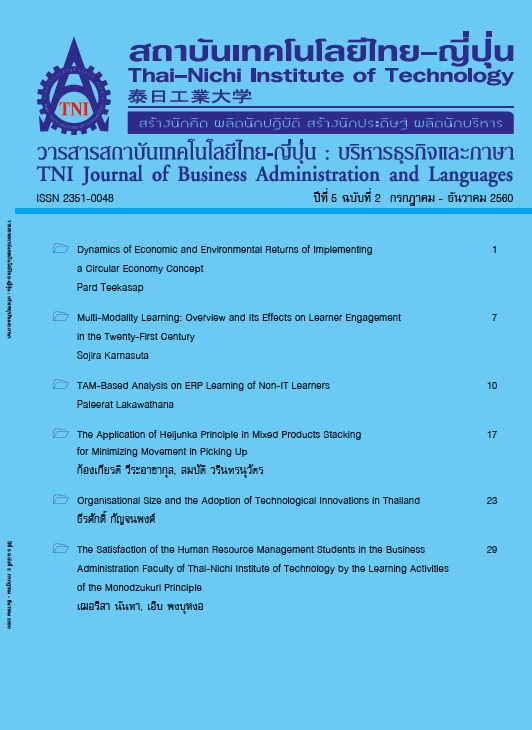TAM-Based Analysis on ERP Learning of Non-IT Learners
Main Article Content
Abstract
Enterprise Resource Planning (ERP) has become a mainstream protocol to integrate the data across an organization. Due to its increasing importance in the business world, many higher educational institutions have organized in-house ERP courses to educate their students including non-IT students (learners) to get ready for future careers. As the objectives of this study, it is interesting to understand how non-IT learners accept to use ERP software and what influences their learning achievement. Here, Technology Acceptance Model (TAM) was applied to analyze the technology acceptance of non-IT learners. The sample data was purposively collected from eighty-eight non-IT undergraduate students enrolled in ERP class at Thai-Nichi Institute of Technology (TNI). Using a path analysis, the influence of two primary TAM factors, perceived usefulness (PU) and perceived ease of use (PEU), was studied. The result shows that both TAM factors have a positive effect on usage intention, indicating the technology acceptance. Regarding the learning achievement by test scores; however, only perceived ease of use has a direct effect whereas perceived usefulness has no direct effect. Perceived usefulness has only the indirect effect on the achievement through the learners’ usage intention. Therefore, it is implicative that user-friendly software is required for non-IT learners to initiate the efforts for achieving the learning outcomes of ERP software.
Article Details
Article Accepting Policy
The editorial board of Thai-Nichi Institute of Technology is pleased to receive articles from lecturers and experts in the fields of business administration, languages, engineering and technology written in Thai or English. The academic work submitted for publication must not be published in any other publication before and must not be under consideration of other journal submissions. Therefore, those interested in participating in the dissemination of work and knowledge can submit their article to the editorial board for further submission to the screening committee to consider publishing in the journal. The articles that can be published include solely research articles. Interested persons can prepare their articles by reviewing recommendations for article authors.
Copyright infringement is solely the responsibility of the author(s) of the article. Articles that have been published must be screened and reviewed for quality from qualified experts approved by the editorial board.
The text that appears within each article published in this research journal is a personal opinion of each author, nothing related to Thai-Nichi Institute of Technology, and other faculty members in the institution in any way. Responsibilities and accuracy for the content of each article are owned by each author. If there is any mistake, each author will be responsible for his/her own article(s).
The editorial board reserves the right not to bring any content, views or comments of articles in the Journal of Thai-Nichi Institute of Technology to publish before receiving permission from the authorized author(s) in writing. The published work is the copyright of the Journal of Thai-Nichi Institute of Technology.
References
L.Columbus (Nov 15, 2016). ERP Market Share Update: SAP Solidifies Market Leadership [Online]. Available: https://www. forbes.com/sites/louiscolumbus/2013/05/12/2013-erp-market-share-update-sap-solidifies-market-leadership/#32ae813d1381
SAP University Alliance (2016). UA Around the World [Online]. Available: https://uaaroundtheworld.informatik.tu-muenchen.de/overview(bD1lbiZjPTEwMQ==)/start.htm
Y.H. Lee, K.A. Kozar, and K.R.T.Larsen, “The Technology Acceptance Model: Past, Present, and Future,” Communications of the association for information systems, vol. 12, pp.752-780, 2003.
M. Chuttur, “Overview of the Technology Acceptance Model: Origins, developments and future directions,” Sprounts: Working Papers on Information System, 9(37), Indiana University, 2009.
F.D. Davis, “A Technology Acceptance Model for empirically testing new end-user information systems: theory and results,” Ph.D. Thesis, MIT, December 1985.
S.Y.Park, “An analysis of the Technology Acceptance Model in understanding university students’ behavioral intention to use e-learning,” Education Technology & Society, 12 (3), pp.160-162, 2009.
W.C. Tsai, “A study of consumer behavioral intention to use e-book: the Technology Acceptance Model perspective,” Innovative Marketing, vol. 8, issue 4, pp. 55-66, 2012.
S. Ros, R. Hernandez, A. Caminero, A. Robles, I. Barbero, A. Macla and F.P. Holgado, “On the use of extended TAM to assess students’ acceptance and intent to use third-generation learning management systems,” British Journal of Educational Technology, vol. 46, no. 6, pp. 1250-1272, 2014.
F.D. Davis, “Perceived usefulness, perceived ease of use, and user acceptance of information Technology,” MIS Quarterly, pp. 319-340, September 1989.
V. Ventatesh and F.D. Davis, “A theoretical extension of the Technology Acceptance Model: four longitudinal field studies,” Management science, vol. 46, no. 2, pp. 186-204, 2000.
S. Brown, A. Massey, M. Montaya-Weiss, and J. Burkman, “Do I really have to?. User acceptance of mandated technology,” European Journal of Information System, vol. 11, pp.283-295, 2002.


